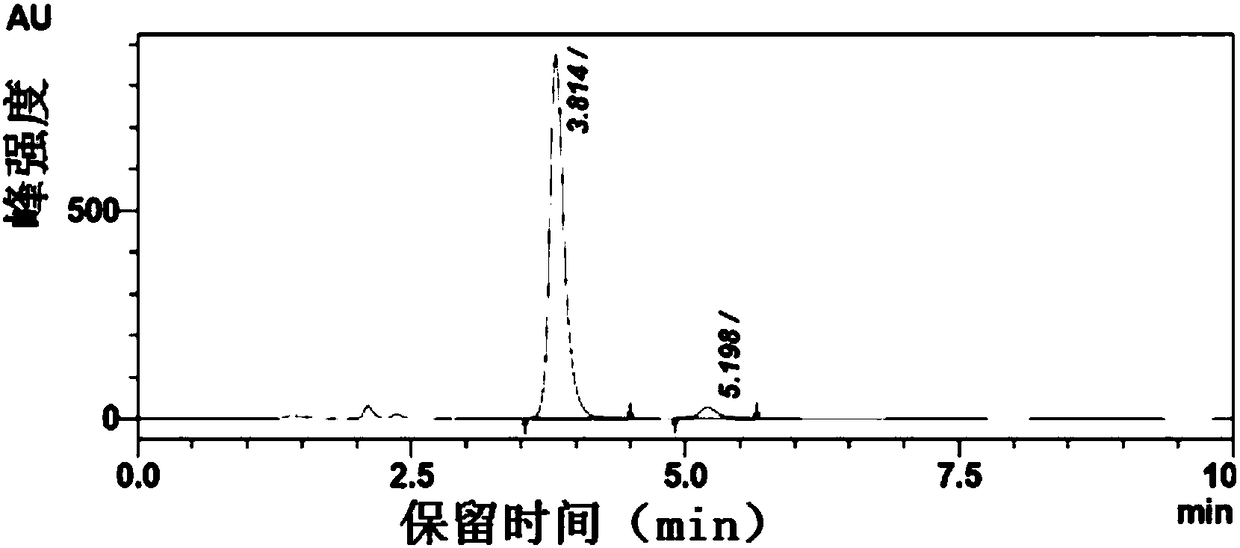Ketoreductase and application thereof in preparation of (S)-2-chloro-1-(3,4-difluorophenyl) ethanol
A difluorophenyl and reductase technology, applied in the field of biological enzymes, can solve the problems of reduced conversion rate, low conversion rate, and reduced application value
- Summary
- Abstract
- Description
- Claims
- Application Information
AI Technical Summary
Problems solved by technology
Method used
Image
Examples
Embodiment 1
[0067] Example 1 Preparation of ketoreductase
[0068] Inoculate the genetically engineered bacteria (vector pET21a, host cell E.Coli BL21(DE3)) containing the coding gene of ketoreductase (SEQ ID No.1) into 5 mL of ampicillin-containing LB test tube medium for activation culture (37°C Culture for 12 hours), transfer the activated culture to 400mL LB liquid medium containing ampicillin according to 1% inoculation amount, culture at 37°C to OD to 0.6-0.8, add IPTG (final concentration 0.1mM) and induce culture at 25°C for 16h. Collect the cells by centrifugation to obtain ketoreductase cells, resuspend the cells in 40mL phosphate buffer (10mM, pH 7.5), and ultrasonically disrupt them in an ice-water bath for 15min, collect the supernatant by centrifugation, pre-freeze at -20°C and then vacuum freeze-dry Crush after 48 hours to obtain recombinant ketoreductase enzyme powder.
Embodiment 2
[0069] Example 2 Preparation of gram-grade (S)-2-chloro-1-(3,4-difluorophenyl)ethanol
[0070] Add isopropanol (4mL) and substrate 2-chloro-1-(3,4-difluorophenyl)ethanone (1.5g) into the reaction vessel, stir well and add 0.5g of ketoreductase cells, coenzyme NADP+ (0.3mg), and finally use phosphate buffer to make up to 10mL, stir the reaction under magnetic force at 25°C, and use NaOH (0.5M) to control the reaction pH at about 6.9, and TLC to detect the reaction progress. After the reaction is completed, diatomite is filtered, the liquid phase is extracted three times with the organic phase, the organic phases are combined, dried over anhydrous sodium sulfate, and spin-dried under reduced pressure to obtain the product. HPLC detection conversion rate and product ee value are attached figure 1 , 2 Shown: Substrate conversion rate = 99.7%, S-type product ee value = 99.8%.
Embodiment 3
[0071] Example 3 Preparation of gram-grade (S)-2-chloro-1-(3,4-difluorophenyl)ethanol
[0072] Add isopropanol (4.5mL) and substrate 2-chloro-1-(3,4-difluorophenyl)ethanone (2.0g) into the reaction vessel, stir well and add 0.75g of ketoreductase cells, coenzyme NADP+ (0.7mg), and finally use phosphate buffer to make up to 10mL, magnetically stir the reaction at 45.5°C, and use NaOH (0.5M) to control the reaction pH at about 6.8, and TLC to detect the reaction progress. After the reaction is completed, diatomite is filtered, the liquid phase is extracted three times with the organic phase, the organic phases are combined, dried over anhydrous sodium sulfate, and spin-dried under reduced pressure to obtain the product. HPLC detection conversion rate as attached image 3 , the product ee value is attached figure 2 : Substrate conversion rate = 99.3%, S-type product ee value = 99.8%.
PUM
 Login to View More
Login to View More Abstract
Description
Claims
Application Information
 Login to View More
Login to View More - Generate Ideas
- Intellectual Property
- Life Sciences
- Materials
- Tech Scout
- Unparalleled Data Quality
- Higher Quality Content
- 60% Fewer Hallucinations
Browse by: Latest US Patents, China's latest patents, Technical Efficacy Thesaurus, Application Domain, Technology Topic, Popular Technical Reports.
© 2025 PatSnap. All rights reserved.Legal|Privacy policy|Modern Slavery Act Transparency Statement|Sitemap|About US| Contact US: help@patsnap.com



